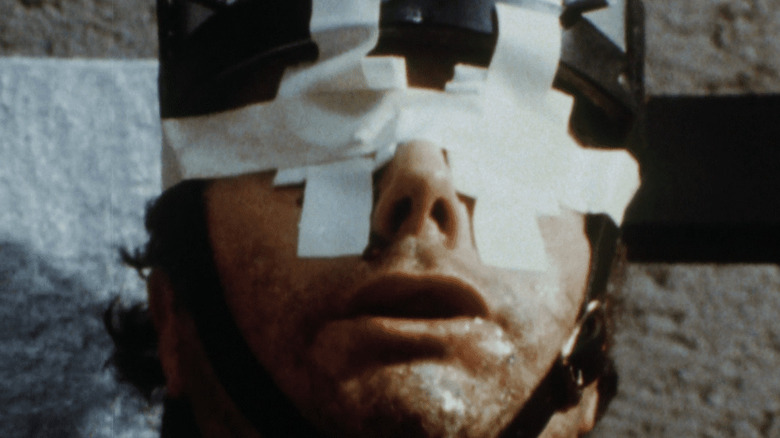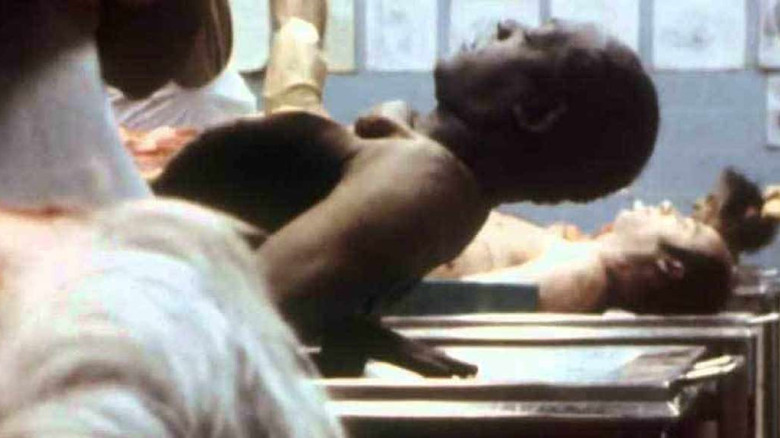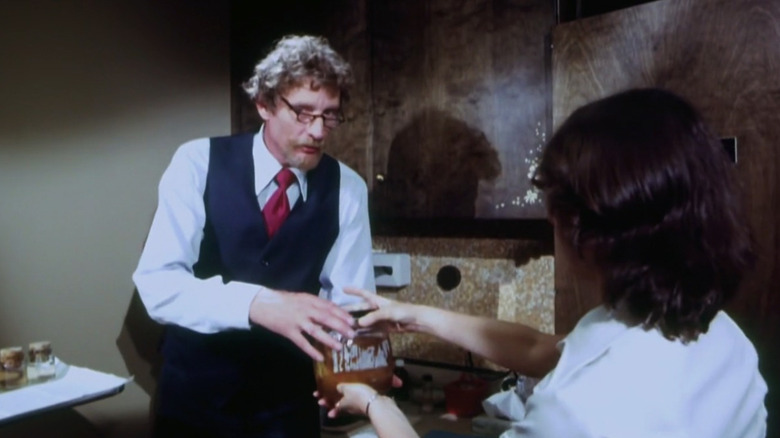The Faces Of Death Controversy Explained: The Story Behind The Movie Your Parents Warned You About
Every generation has its morbid rite of passage — the midnight movie you snuck into with friends on a dare, the rotten website full of blue hyperlinks that should stay blue. Those of a certain age who were weaned on the offerings from the local mom and pop video store are likely familiar with one of its most notorious relics: John Alan Schwartz's mondo horror film "Faces of Death."
You didn't even have to have a video shop membership to have gotten your hands on it; it probably came from an older sibling's friend who had a grainy third-generation copy of the original tape. By the time it got to your VHS player, there was already a forbidden energy in the room. After all, the cover talks up a big game with a skull against a black background, amid the claim that the film was "banned in 46 countries!" And then there's the tagline: "Experience the graphic reality of DEATH, close-up..." Underneath, a disclaimer warns potential viewers that graphic images of dismemberment, autopsy, and even human combustion await them should they press play, and that the film is not for "children, the elderly, or the squeamish." The warnings worked as well as any William Castle gimmick, and it got butts in theater seats. Despite a poor critical reception, "Faces of Death" grossed over $35 million worldwide on its meager budget, spawning a handful of sequels and a whole lot of controversy. The cult following it gained also prompted the release of a handful of sequels, and word of mouth secured the franchise's place in the history of weird cinema.
Now, a remake is on the way from the makers of "Cam," prompting a look back on "Faces of Death" and the controversy it generated. Legendary Entertainment (behind "Godzilla vs. Kong" and under-seen found footage horror "As Above, So Below") is backing a fresh iteration of "Faces of Death," with Isa Mazzei and Daniel Goldhaber at the helm. This time, the story involves a YouTube moderator who discovers a group of people recreating the deaths from the original movie. So whether you're new to this or know this thing inside and out (hello), let's take a look back at the original film and the controversy it generated.
A Whole New World
The film's beginning is told via narration by one Dr. Francis B. Gross (played by Michael Carr), a pathologist whose experiences with death have given him "a greater awareness of the living." As a self-proclaimed "creative consultant," Gross is there to give the subject matter some verisimilitude, opining:
"Prepare yourself for a journey into a world where each new step may give you a better understanding of your own reality, for I am sure you will gain a new perspective from the many faces of death."
Over the course of the film, we are shown death by murder, by ritual, by punishment, and by accident. Special effects artist Allan A. Apone attributes about "40 percent" of the film to his fabricated handiwork in scenes of fake death, leaving the other 60% as genuine footage. The shocks are enhanced as most Mondo films are, with sound design doing some heavy lifting and emphasizing the crunch of bone and the squelch of flesh. Director Schwartz leaned into his experience in the editing bay for Leonard Nimoy's "In Search Of..." TV series, presenting all footage in the "Believe it or not!" style of Mondo cinema.
Friends on The Other Side
"Face of Death" plays all the Mondo hits: violent freak accidents, "barbaric" indigenous tribes, bizarre-to-us ceremonies, and wholesale animal slaughter by abattoir or by ritual. The images are meant to titillate, but even unintentionally, they serve a transgressive purpose. In his culture book, "Film as a Subversive Art," author Amos Vogel calls true onscreen death "taboo in its purest form," one of the last untouched visuals of the medium; the imagery brings abstract forbidden topics into a tangible reality.
Death is a taboo explored throughout most Mondo cinema, with some (like the 1979 Belgian funeral dirge "Des Morts") explicitly dedicating narration to ruminating on death and dying. "Faces of Death" achieves this to a lesser degree, leaving the morbid discourse to a few mortuary shots and some sad brass accompaniment. There are earlier works in the Mondo canon that succeed in unpacking our morbid thoughts in a way that approaches art: "Des Morts" and "Mondo Candido" set the bar high for shock docs by attributing them to moral determinism, not so much celebrating depravity as they resign themselves to it as a part of the human experience. "Faces of Death" never approaches that artsy line, but its shocks were real enough to upset the powers that be.
Poor Unfortunate Souls
With the advent of home video came an unprecedented level of access to lowbrow art; you didn't have to endanger yourself prowling The Deuce to see a midnight show. With the new avenue for media came new efforts to censor and limit its reach. Mary Whitehouse, England's analog to Tipper "Parental Advisory" Gore, joined forces with the National Viewers And Listeners Association to crusade against what she and conservatives perceived as a national moral decline.
To remedy what they saw as slipping family values, Whitehouse and the NVALA raised a stink with lawmakers to limit the availability of "filth" for young viewers by going after adults. Because VHS tapes weren't subject to scrutiny by the British Board of Film Classification (BBFC), they could skirt the ratings process and go onto the market uncensored. Using an old law, the Obscene Publications Act of 1959, law enforcement was able to prosecute individuals trading any materials deemed offensive, leading to the list of 72 films in violation of the Act, some of which were colloquially dubbed "Video Nasties." In 1983, "Faces of Death" was added to the list by the Director of Public Prosecutions, joining the likes of Lucio Fulci's "Zombie" and Abel Ferrara's "The Driller Killer" in cinema infamy. This meant that distributors and video store owners could face fines and jailtime just for having copies of the movie in its possession. Stores were subject to raids, and Nasties were subject to confiscation.
As to its claim to be banned in over 40 countries, there's not much evidence to support that number beyond a few notable documented restrictions; rather, the claim can be partially chalked up to more of that sweet, sweet promotional ballyhoo. The ban was as successful as any media ban is, and bootleg tapes of "Faces of Death" circulated far and wide until censor standards loosened in the 2000s. Now, the film can be found streaming on multiple services, where the many faces of death are a remote click away. Mark Goodall's book, "Sweet and Savage: The World Through the Mondo Film Lens," cites "Faces of Death" as a signal of "the end of the classic Mondo period" with everything afterwards being a shameless mimic, but even the Mondo scholar acknowledges the film's legacy as one of the most notorious pillars of the shockumentary subgenre.
The film is currently streaming on Tubi, if you're nasty enough.


